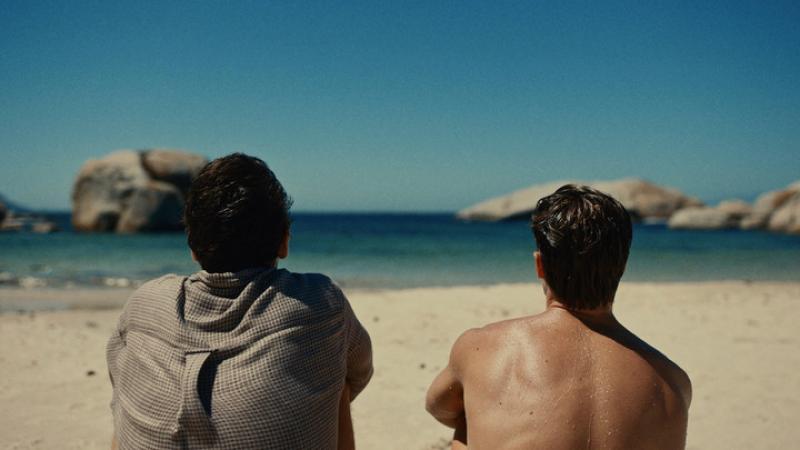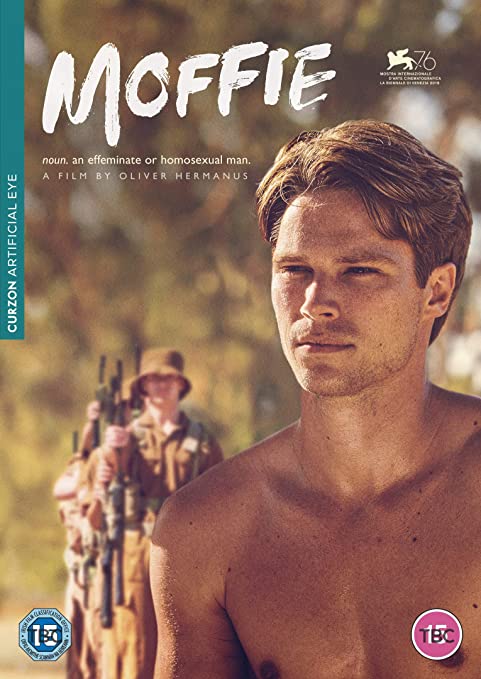DVD/Blu-ray: Moffie | reviews, news & interviews
DVD/Blu-ray: Moffie
DVD/Blu-ray: Moffie
Young love and brutal violence in the theatre of war

Characterised by jarring juxtapositions of intense, appalling violence and the serene beauty of South Africa, Oliver Hermanus’ fourth feature is the story of a young man coming to terms with his sexuality against the background of apartheid and prejudice.
It's set in 1981, over a decade before homosexuality was legalised in South Africa, when any expression of same-sex attraction in the military meant a trip to Ward 22, where Dr Aubrey Levin subjected his patients to inhumane "treatments". The threat of this punishment hangs over the protagonist, Nick van der Swart (Kai Luke Brummer), its effects seen in others as he attends a military training camp in the desert.
However heavy Moffie can be at points, Nick’s emotional disconnect lends an abstraction that saves it from being overwhelming. He often looks directly at the camera but his character and face have an inscrutability that creates distance. This dislocation and disconnection is characteristic of the film, perhaps an echo of the reality of a gay man whose physical encounters must be constantly controlled. At the point where Nick experiences his first kiss, the action shifts back in time to his childhood, to when he was caught spying on a boy changing at the pool and humiliated in front of a crowd. With age, the consequences only grow worse.

The music for Moffie is particularly well chosen and renders the horrific almost beautiful. One of the most intense moments occurs towards the start, an aerial shot showing the train winding its way through the scrub to the training camp that's overlaid by sparse, ominous strings.
The horror of apartheid is shown starkly here, when a single black man has a bag of sick thrown at him for sitting on the wrong bench. There is only one other scene with black characters in Moffie, their mute suffering a terrible reminder of deeply entrenched racism. There is a distinctly uncomfortable homogeneity to Moffie as a whole. Most of the film is occupied by young white males, and the unwholesomeness of racial purity is expressed by this corrupted monoculture.
There is also something very unsettlingly childlike about the characters and their setting. The training camp has something of the feel of a holiday camp, albeit one with routine abuse and brutal fighting. This is only intensified as the audience is reminded that they are only in their late teens at points of extreme violence. Just before the troop goes to the border with Angola (the frontline in the current war), they try to pick up girls in a bar, their youthful innocence a painful contrast with their next day’s duty.
The film's real strength is this, showing the strange mix of fragility and brutality that young men possess, partly reflected in the film’s setting. It depicts very well the point at which their plasticity hardens into violent hatred, in a country formed by oppression and cruelty. It is particularly interesting that the film concludes at the edge of the ocean, expressing a potential freedom that could never be granted in the arid interior.
rating
Explore topics
Share this article
The future of Arts Journalism
You can stop theartsdesk.com closing!
We urgently need financing to survive. Our fundraising drive has thus far raised £49,000 but we need to reach £100,000 or we will be forced to close. Please contribute here: https://gofund.me/c3f6033d
And if you can forward this information to anyone who might assist, we’d be grateful.

Subscribe to theartsdesk.com
Thank you for continuing to read our work on theartsdesk.com. For unlimited access to every article in its entirety, including our archive of more than 15,000 pieces, we're asking for £5 per month or £40 per year. We feel it's a very good deal, and hope you do too.
To take a subscription now simply click here.
And if you're looking for that extra gift for a friend or family member, why not treat them to a theartsdesk.com gift subscription?
more Film
 London Film Festival - from paranoia in Brazil and Iran, to light relief in New York and Tuscany
'Jay Kelly' disappoints, 'It Was Just an Accident' doesn't
London Film Festival - from paranoia in Brazil and Iran, to light relief in New York and Tuscany
'Jay Kelly' disappoints, 'It Was Just an Accident' doesn't
 Iron Ladies review - working-class heroines of the Miners' Strike
Documentary salutes the staunch women who fought Thatcher's pit closures
Iron Ladies review - working-class heroines of the Miners' Strike
Documentary salutes the staunch women who fought Thatcher's pit closures
 Blu-ray: The Man in the White Suit
Ealing Studios' prescient black comedy, as sharp as ever
Blu-ray: The Man in the White Suit
Ealing Studios' prescient black comedy, as sharp as ever
 The Woman in Cabin 10 review - Scandi noir meets Agatha Christie on a superyacht
Reason goes overboard on a seagoing mystery thriller
The Woman in Cabin 10 review - Scandi noir meets Agatha Christie on a superyacht
Reason goes overboard on a seagoing mystery thriller
 London Film Festival 2025 - crime, punishment, pop stars and shrinks
Daniel Craig investigates, Jodie Foster speaks French and Colin Farrell has a gambling habit
London Film Festival 2025 - crime, punishment, pop stars and shrinks
Daniel Craig investigates, Jodie Foster speaks French and Colin Farrell has a gambling habit
 I Swear review - taking stock of Tourette's
A sharp and moving tale of cuss-words and tics
I Swear review - taking stock of Tourette's
A sharp and moving tale of cuss-words and tics
 A House of Dynamite review - the final countdown
Kathryn Bigelow's cautionary tale sets the nuclear clock ticking again
A House of Dynamite review - the final countdown
Kathryn Bigelow's cautionary tale sets the nuclear clock ticking again
 theartsdesk Q&A: Idris Elba on playing a US President faced with a missile crisis in 'A House of Dynamite'
The star talks about Presidential decision-making when millions of lives are imperilled
theartsdesk Q&A: Idris Elba on playing a US President faced with a missile crisis in 'A House of Dynamite'
The star talks about Presidential decision-making when millions of lives are imperilled
 Urchin review - superb homeless drama
Frank Dillane gives a star-making turn in Harris Dickinson’s impressive directorial debut
Urchin review - superb homeless drama
Frank Dillane gives a star-making turn in Harris Dickinson’s impressive directorial debut
 Mr Blake at Your Service review - John Malkovich in unlikely role as an English butler
Weird comedy directed by novelist Gilles Legardinier
Mr Blake at Your Service review - John Malkovich in unlikely role as an English butler
Weird comedy directed by novelist Gilles Legardinier
 Don't Let's Go to the Dogs Tonight review - vivid adaptation of a memoir about a Rhodesian childhood
Embeth Davidtz delivers an impressive directing debut and an exceptional child star
Don't Let's Go to the Dogs Tonight review - vivid adaptation of a memoir about a Rhodesian childhood
Embeth Davidtz delivers an impressive directing debut and an exceptional child star

Add comment